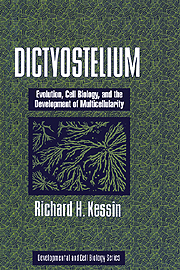Book contents
- Frontmatter
- Contents
- Preface
- 1 A Brief Introduction to Dictyostelium discoideum and its Relatives
- 2 A History of Research on Dictyostelium discoideum
- 3 The Evolutionary Biology of Dictyostelium
- 4 The Genome and Genetics
- 5 Membranes and Organelles of Dictyostelium
- 6 Cell Motility and the Cytoskeleton
- 7 The Transition from Growth to Development: From Starvation to Self-Sustaining cAMP Signal Relay
- 8 Chemotaxis and Aggregation
- 9 Differentiation and Adhesion in the Aggregate
- 10 The Behavior of Cells in the Slug
- 11 Culmination
- 12 Formation and Germination of Spores
- 13 Resources
- References
- Index
- Plate section
4 - The Genome and Genetics
Published online by Cambridge University Press: 07 October 2009
- Frontmatter
- Contents
- Preface
- 1 A Brief Introduction to Dictyostelium discoideum and its Relatives
- 2 A History of Research on Dictyostelium discoideum
- 3 The Evolutionary Biology of Dictyostelium
- 4 The Genome and Genetics
- 5 Membranes and Organelles of Dictyostelium
- 6 Cell Motility and the Cytoskeleton
- 7 The Transition from Growth to Development: From Starvation to Self-Sustaining cAMP Signal Relay
- 8 Chemotaxis and Aggregation
- 9 Differentiation and Adhesion in the Aggregate
- 10 The Behavior of Cells in the Slug
- 11 Culmination
- 12 Formation and Germination of Spores
- 13 Resources
- References
- Index
- Plate section
Summary
The genome is relatively small and will be sequenced soon
The chromosomes of Dictyostelium are at the limit of light microscopic detection, and although seven are generally observed, the physical and genetic maps of the genome reveal only six chromosomes. Originally, the genome size was determined to be about 50 megabases (Mb) (Firtel and Bonner, 1972; Sussman and Rayner, 1971), about 1% of the size of the human genome, and about 11–12 times that of E. coli. More recent estimates yield a genome size of 34 Mb (Cox et al., 1990; Kuspa and Loomis, 1996).
One of the curiosities of the genome is its extreme AT-richness, especially in intergenic regions and introns. The stop codon is nearly always TAA. Coding sequences are skewed to an AT bias – when the third position of a codon can be an A or a T, it usually is. Overall, the base composition is 77% AT, while in coding sequences A and T constitute about 65% (Firtel and Bonner, 1972; Kimmel and Firtel, 1982; Sussman and Rayner, 1971). Other organisms such as Plasmodia falciparum are also exceptionally AT-rich, though what led to this AT-richness is unknown.
There is another strange element in the genome – coding sequences tend to have long repeats of the triplet AAC (Kimmel and Firtel, 1985; Shaw et al., 1989). The AAC repeats are present in all three reading frames, leading to long stretches of asparagine, glutamine, or threonine in the deduced proteins (Shaw et al., 1989).
- Type
- Chapter
- Information
- DictyosteliumEvolution, Cell Biology, and the Development of Multicellularity, pp. 40 - 58Publisher: Cambridge University PressPrint publication year: 2001



